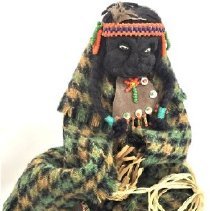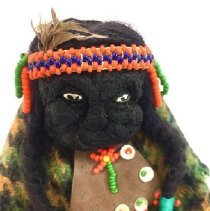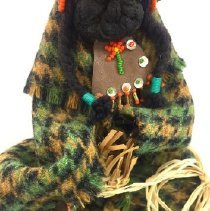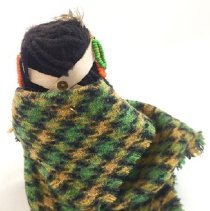Object Record
Images




Metadata
Object Name |
Doll |
Object Number |
2019.026.011 |
Description |
Apple-head doll Indigenous female apple-head doll; doll is in a seated position and is in the process of weaving a basket; doll’s head and hands are carved from an apple; the apple is blackened and wrinkled giving the doll an elderly appearance; the doll’s hair is black yarn; hair is styled into two braids with blue-green coloured ties around each end; orange, purple, and light green beaded leather headband attached to head; small brown coloured feather inserted into headband; two painted pearls as eyes; the doll wears a yellow, green, and black coloured shawl-like dress with a beaded leather collar; the collar is decorated with an orange flower and orange and brown beaded fringe; light brown coloured leather moccasins attached to doll’s feet; moccasins decorated with a red and green flower on the toes and green tassels on the sides. |
Provenance |
Apple-head doll made by Alberta "Berta" Shier (b. Dec. 12, 1908, Cayley, Alberta - d. Sept. 28, 1999, Chilliwack, British Columbia). The doll was donated by Marie Weeden. The practice of creating apple-head dolls is believed to have originated with Indigenous groups in North America prior to European settlement. The Oneidas and Seneca who lived in the northeastern United States made dolls from crabapples and later, apples brought by European settlers (Megan Mac Gregor, "Creation in the Hand The Life in Folk Art Dolls," Historia 16 (2007): 127). Since European settlement, apple-head dolls have been crafted by both Indigenous and non-Indigenous people for personal, art, and commercial purposes. For example, the Skookum Indian Doll, first patented by Mary Dwyer McAboy (b. March 11, 1876, Fairfield, Maine - d. Dec. 26, 1961, Norfolk, Connecticut) in 1914 was a widely successful Indigenous themed apple-head doll produced and sold in the United States from the 1920s - 1960s (http://prairiemuseum.blogspot.com/2016/02/skookum-indian-dolls.html). In Canada, during the mid 20th century, an Indian Arts and Crafts Movement emerged which encouraged the making of handicrafts as an economic activity for Indigenous peoples. Arts and crafts production was added to the curriculum of some residential schools, such as Coqualeetza in the Fraser Valley area (http://openmov.museumofvancouver.ca/object/ethnology/aa-2829). Berta moved to Hope, British Columbia from Alberta with her husband Frank Shier in 1945. In 1948, the couple moved to a home on Spadina Avenue in Chilliwack; in 1952 they moved to McNaught Road. Berta was an art enthusiast; she spent time working on pottery, ceramics, painting, and studying with local artists. Berta taught crafts to a youth group in Hope before working as an occupational therapist at the Coqualeetza Indian Hospital, it was at the Hospital where she states that she was first introduced to apple-head dolls, presumably from an Indigenous patient (Iris Keller, "Apple Art," Beautiful British Columbia 13, no.2 (Fall 1971):36-37). Berta developed her apple carving skills and became renowned in the local area for her apple art dolls; her work was highlighted in the 1971 Fall edition of the magazine Beautiful British Columbia (see artifact file). Depending on the ethnicity of the intended doll, Berta would either treat the apple with lemon juice (for a Caucasian doll) or allow the doll to naturally darken (for an Indigenous or Asian doll). Berta intended for this doll to be Indigenous therefore the apple was untreated. Berta would add pearl eyes, wigs, and touch up the dolls faces using pens and watercolour paints (Keller, "Apple Art," 37). Berta would create costumes and props for her dolls; for Indigenous dolls she would enlist local Indigenous women to produce the beadwork and weavings (Keller, "Apple Art," 37). Upon the closure of the Coqualeetza Hospital in 1969, Berta worked at the Chilliwack Extended Care Facility and she continued to craft apple-head dolls in her spare time (The Chilliwack Progress, Oct. 15, 1999, B8). |
